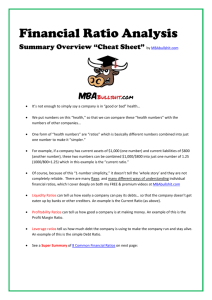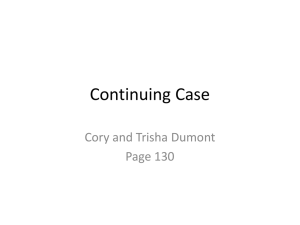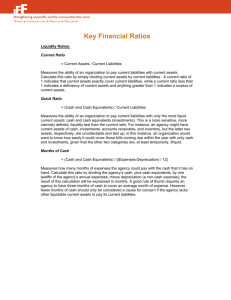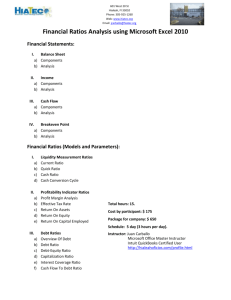Part IV
advertisement
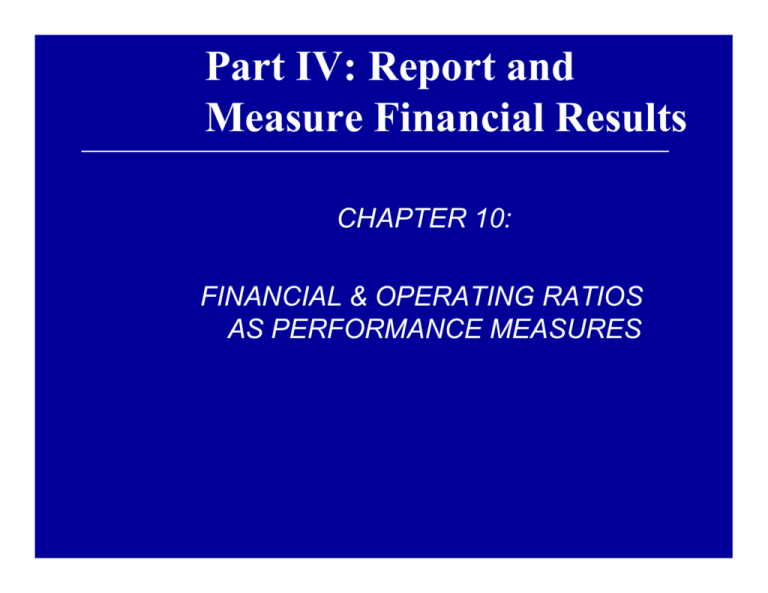
Part IV: Report and Measure Financial Results CHAPTER 10: FINANCIAL & OPERATING RATIOS AS PERFORMANCE MEASURES The Importance of Ratios Ratios are important because they are so widely used. Financial ratios are especially important because they are used for credit analysis. See Appendix 18-A for multiple examples of financial ratios as used for credit analysis and financing purposes. The Importance of Ratios 3 types of ratios: Liquidity, solvency, and profitability These three types include eight basic ratios that are widely used in health care organizations. Liquidity — current ratio; quick ratio; days cash on hand; days receivables. Solvency — debt service coverage; liabilities to fund balance. Profitability — operating margin; return on total assets. Liquidity Ratios Current Ratio — A measure of short-term debt-paying ability (but it must be carefully interpreted). Computed as: current ratio = current assets/ current liabilities. (Also see practice exercises for this chapter.) Liquidity Ratios Quick Ratio — An even more severe test of short-term debt-paying ability (it also must be carefully interpreted). Computed as: quick ratio= cash & cash equivalents + net receivables / current liabilities Also see practice exercises for this chapter. Liquidity Ratios Days Cash on Hand (DCOH) — Indicates cash on hand in relation to amount of daily operating expenses. Computed as: DCOH = unrestricted cash & cash equivalents / cash operating expenses / # of days in period. Also see practice exercises for this chapter. Liquidity Ratios Days Receivables — Represents number of operating days in receivables (a measure of worth as well as performance). Computed as: days receivables = net receivables / net credit revenues / # of days in period Also see practice exercises for this chapter. Solvency Ratios Debt Service Coverage (DSCR) — Represents the ability to meet required debt service (this ratio is universally used in credit analysis). Computed as: DSCR = change in unrestricted net assets (net income) + interest, depreciation, and amortization / maximum annual debt service Also see practice exercises for this chapter. Solvency Ratios Liabilities to fund balance — Represents the relationship of liabilities to fund balance (or liabilities to net worth). A quick indicator of bad debt. Computed as: liabilities for fund balance = total liabilities / unrestricted net assets (fund balances) or (net worth) Also see practice exercises for this chapter. Profitability Ratios Operating Margin (expressed as a percentage) — Represents the relationship of operating revenues to operating income. A multi-purpose measure, used for many managerial purposes; sometimes also used for credit analysis Computed as: operating margin = operating income (loss) / total operating revenues. Also see practice exercises for this chapter. Profitability Ratios Return on total assets (expressed as a percentage) — Represents the yield received in relation to total assets. A broad measure in common use. Computed as: return on total assets = earnings before interest and taxes (EBIT) / total assets. Also see practice exercises for this chapter. Importance of Ratios Remember, ratio analysis should be conducted as a comparative analysis. When interpreting ratios, the differences between periods must be considered, and the reasons for such differences should be sought. Current Ratio 1. Current Ratio 470,000 345,000 = 1.362 Current Assets Current Liabilities Quick Ratio 2. Quick Ratio 190,000+250,000 345,000 = 1.275 Cash and Cash Equivalent + Net Receivables Current Liabilities Days Cash on Hand Ratio Step 1 1,885,000 (40,000) 1,845,000 3. Days Cash on Hand (DCOH) Step 2 1,845,000 365 = 5,055 Step 3 190,000 5,055 = 37.5 days Unrestricted Cash and Cash Equivalents Cash Operating Expenses divided by # days in period (365) Days Receivable Ratio Step 1 2,000,000 x 90% 1,800,000 4. Days Receivables Percent of Credit Revenues Information obtained elsewhere Step 2 1,800,000 365 = 4931 Step 3 250,000 4931 = 50.7 days Net Receivables Net Credit Revenue divided by # days in period (365) Return on Total Assets Step 1 120,000 (20,000) 100,000 Step 2 100,000 963,000 = 10.03% 5. Return on Total Assets (%) EBIT (Earnings Before Interest and Taxes) Total Assets Operating Margin Ratio 6. Operating Margin (%) 115,000 2,000,000 = .0575% Operating Income (Loss) Total Operating Revenues Liabilities to Fund Balance Ratio 7. Liabilities to Fund Balance 545,000 418,000 = 1.304 Total Liabilities Unrestricted Fund Balance Debt Service Coverage Ratio Step 1 120,000 20,000 40,000 180,000 8. Debt Service Coverage Ratio (DSCR) Change in Unrestricted Net Assets (net income) plus Depreciation-Amortization plus Interest Maximum Annual Debt Service Step 2 180,000 72,000 = 2.5 Maximum Annual Debt Service Information derived elsewhere

